Collaboration and Community
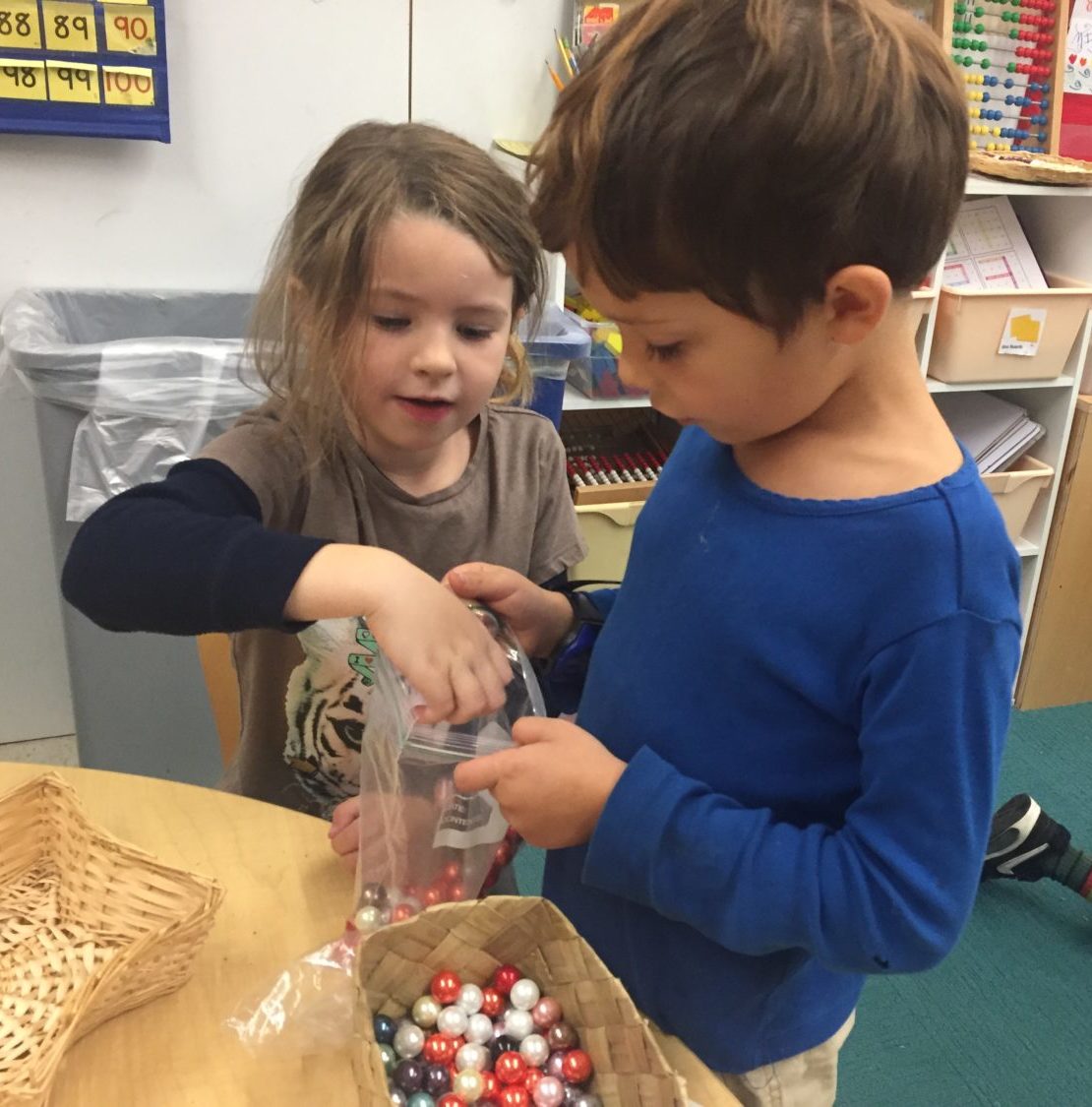
One of the goals and expectations that the primary team pinpointed in our intention letter this year was, “to develop strategies that contribute to the quality of the community by collaborating with others to construct ideas and create new knowledge.”
This has remained at the forefront of my mind in first grade math, as the first graders have spend the first months of the school year focused on discovering new strategies for counting. The children have been counting objects, coming together to share their strategies, and inspiring each other to have a go at a new strategy.
As I reflected on this goal and expectation and observed the children, I wondered how authentic counting opportunities might also be opportunities for community building. Specifically, what strategies might support us as we collaborate with others? How will these strategies support our math community as a whole? The primary community as a whole? What fresh ideas might we construct because we are working in collaboration? What is the relationship between collaboration and the development of new knowledge?
In early October, I reflected with Heather about my hopes for our counting work. Heather shared with me that the Dogwood community was having a counting dilemma of their own! Some second graders had brought in a large amount of chestnuts and were trying to count them but were getting stuck. Together, we wondered about our math communities and what might be possible if they supported each other’s counting.
The next day, I collected a large bag full of chestnuts from the Dogwood classroom and presented Dogwood’s chestnut dilemma to the first graders. They responded with a lot of excitement! Chester said, “I know we can help them!” and Abbott added, “I wonder if they know our strategies…maybe we can show them some new ones.” Together we divided up the chestnuts and the children collaborated with the people sitting near them to count how many chestnuts were in their portion.
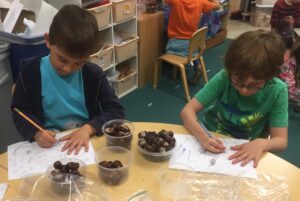
When we came back together, the children used a variety of strategies to find total amounts for their bags of chestnuts. We made a list of all their strategies and totals on the whiteboard and wondered together how we might add all these totals to get an amount.
I was feeling nervous. These numbers were the largest that we’d dealt with so far. While I had confidence in the children’s capabilities, I also feared I was presenting them with a challenge that might feel discouraging. I knew, as our goal and expectation indicated, that collaborating with others to construct new ideas would enhance the quality of our community. I wanted the next steps to come from the children and I felt unsure of where they might go from here. I reminded myself of times that I’d felt this way in the past and how, in those stories, listening to the children often revealed possibilities that I hadn’t thought of myself.
Together we sat looking at our list of numbers on the whiteboard. One child offered a solution. “I think there are 1,000 because it looks like 1,000!” Another child responded, “That’s estimating and we have to really know!” A few more silent moments passed before Vanya decided to take a risk. He said, “I think the numbers we have are too big. It feels too hard.” I felt grateful that Vanya was willing to take a risk and share and I worried that he felt discouraged. I wondered how this might be an opportunity for us to strengthen our community by supporting each other. I asked the children if others were feeling similarly and Ben added, “I don’t think the numbers are too big…but I can’t figure out what strategy to use.” Mira (who had recently discovered groups of ten) added, “I like tens! Let’s try tens!” Vanya and the rest of the children agreed that they could all split their chestnuts into groups of ten.
As I reflected on this conversation later, I was impacted by Vanya’s willingness to be vulnerable and share his worry. He trusted his math community enough to share that a challenge was feeling too hard for him and his community responded gently by using their strategies to offer support. Vanya opened the door for Ben and Mira to uncover what they were really needing – to return to the materials. 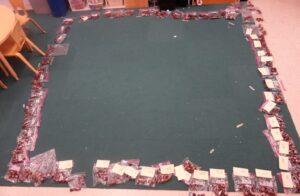
When the children finished, we lined the perimeter of our rug with their groups of ten and stood back to observe. There was a lot of excitement around how the rug looked; the children could not believe how many groups of ten there were! Stella exclaimed, “This is like the cover of a book!” The idea of making a book about the chestnuts immediately excited the community. I asked them who they imagined the audience for their book being. Wilco said, “Dogwood!” And the children agreed that Dogwood would be the main audience for their writing.
I began to wonder about the community building opportunities that moving forward with a book might provide. What might we learn about each other through shared authorship? What ideas and new knowledge might we uncover together by collaborating on a book? What opportunities for using strategies might collaborating in this way present? How might these strategies strengthen our community as a whole?
Over the next two weeks we pieced together the pages of our book which show each child’s chosen strategy. The children set up strategy demonstrations, I snapped photos, and then each child captured words on a post-it explaining what was happening in their strategy picture. We also collaborated to write a shared author’s note and the end page of our book, which shows our tens strategy for finding the total number of chestnuts.
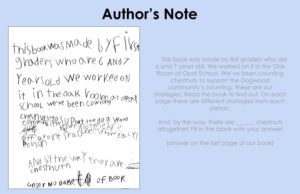
On Friday, our book was finished. We spent some time reading and celebrating together and then visited Dogwood to share our chestnut story with the second graders. The first graders explained what we had been doing with the chestnuts, each first grader took turns reading their strategy page in our book, and then the second graders asked questions and made comments. 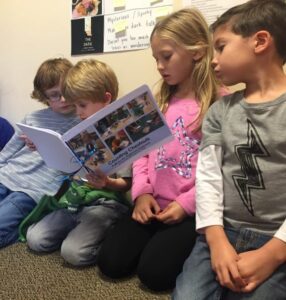
As I listened to the first- and second graders, I was struck by the way each group expressed gratitude for the other while also nudging each other’s thinking. Aleeza (second grade) shared, “I liked how you showed different strategies on the pages in your book.” And Aurelia (second grade) invited, “You know, we have more chestnuts at my house — like thousands. We could bring more. Are you going to do a Book Two?”
In reflection, I was reminded again of the goal and expectation that the primary team had highlighted in our intention letter at the beginning of the year. The first graders had spent weeks in collaboration with each other to construct new ideas. Further, they pieced together a book that shared their process, honored themselves as individuals and as a whole, and communicated new knowledge with their intended audience. They had bumps along the way but supported each other through the bumps because they valued collaboration and sharing ideas.
As we move forward as a community of mathematicians, I am curious how this experience might serve as a foundation for future collaboration. What is possible now that we have navigated bumps together and had experience relying on each other for support through the bumps? In what ways has our community become a safer place to be vulnerable? How might willingness to be vulnerable allow us to find new ideas and knowledge together?
I’m curious about what you are noticing within your learning communities:
- How is collaboration supporting new ideas and the development of new knowledge in your classroom?
- What happens when you encounter a bump together?
- What is the relationship between collaboration and generation of new ideas and knowledge?

Sarah, it’s really exciting to read your reflections on this experience. It’s so apparent that your math community recognized their counting (book) had real work to do in the world!
Thanks MaryGage! I noticed a major shift in their engagement and energy when they recognized that their work had an authentic purpose! This was so exciting for all of us.
Will you share your book with the Alder classroom? We have been thinking a lot about big numbers too, and we might benefit from some of the strategies in the book (I’m also so curious about how many chestnuts there were!)
I’m also excited to think about the possibilities “bumps” offer our community while we’re working toward our understanding of collaboration, and how vulnerability plays a role in discovering strategies. I’ll be thinking about these questions as we keep thinking about collaboration in our classroom community. Thanks for the nudge!
Thanks for your thoughtful comment, Leslie! I will bring you a copy of the book by Monday. I’d love to hear more about the wondering that Alder has been doing about counting!
My favorite part is how math inspired writing a book. They instantly want to share ideas with others and that’s so important in life!